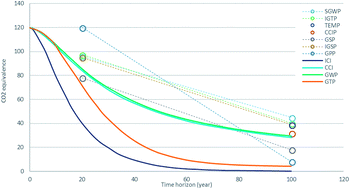Methane emissions: choosing the right climate metric and time horizon
Abstract
Methane is a more potent greenhouse gas (GHG) than CO2, but it has a shorter atmospheric lifespan, thus its relative climate impact reduces significantly over time. Different GHGs are often conflated into a single metric to compare technologies and supply chains, such as the global warming potential (GWP). However, the use of GWP is criticised, regarding: (1) the need to select a timeframe; (2) its physical basis on radiative forcing; and (3) the fact that it measures the average forcing of a pulse over time rather than a sustained emission at a specific end-point in time. Many alternative metrics have been proposed which tackle different aspects of these limitations and this paper assesses them by their key attributes and limitations, with respect to methane emissions. A case study application of various metrics is produced and recommendations are made for the use of climate metrics for different categories of applications. Across metrics, CO2 equivalences for methane range from 4–199 gCO2eq./gCH4, although most estimates fall between 20 and 80 gCO2eq./gCH4. Therefore the selection of metric and time horizon for technology evaluations is likely to change the rank order of preference, as demonstrated herein with the use of natural gas as a shipping fuel versus alternatives. It is not advisable or conservative to use only a short time horizon, e.g. 20 years, which disregards the long-term impacts of CO2 emissions and is thus detrimental to achieving eventual climate stabilisation. Recommendations are made for the use of metrics in 3 categories of applications. Short-term emissions estimates of facilities or regions should be transparent and use a single metric and include the separated contribution from each GHG. Multi-year technology assessments should use both short and long term static metrics (e.g. GWP) to test robustness of results. Longer term energy assessments or decarbonisation pathways must use both short and long-term metrics and where this has a large impact on results, climate models should be incorporated. Dynamic metrics offer insight into the timing of emissions, but may be of only marginal benefit given uncertainties in methodological assumptions.

- This article is part of the themed collection: Best Papers 2018 – Environmental Science: Processes & Impacts


 Please wait while we load your content...
Please wait while we load your content...